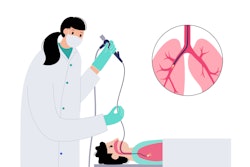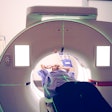
Patients who suffer from the effects of long COVID may be more likely to develop lung and heart diseases if they have abnormal cardiopulmonary PET/MRI results. This is according to a new study, “Prevalence of Persistent Cardiovascular and Pulmonary Abnormalities on PET/MRI and DECT Imaging in Long COVID Patients,”published in The Journal of Nuclear Medicine.
In the United States, long COVID affects between one-third and two-thirds of patients months after recovery from the initial infection. The study included the largest cohort of long COVID patients and the longest follow-up duration. Its findings suggest that people who have irregular PET/MRI scans should be monitored closely due to an increased risk of lasting health concerns.
“Unfortunately, the long-term consequences of long COVID remain unknown. In this study, we sought to use advanced cardiopulmonary imaging to assess for evidence of cardiac and lung abnormalities, vascular injury and inflammation in patients with long COVID,” said lead author Maria Giovanna Trivieri, MD, PhD, FACC, FRCPC, in a press release. Dr. Trivieri is associate professor of medicine (cardiology) and radiology at the Icahn School of Medicine, Cardiovascular Research Institute, Biomedical and Molecular Imaging Institute, in New York.
The study included 98 patients with a history of COVID infection, ongoing cardiopulmonary symptoms nine to 12 months after initial infection and a clinical assessment compatible with long COVID. It also assessed a control group of subjects with a history of severe COVID-19 but without cardiopulmonary symptoms for comparison. Both groups underwent cardiopulmonary F-FDG PET/MRI and dual energy CT (DECT) of the lungs. A subgroup of patients also underwent a plasma protein analysis.
In 57% of long COVID patients, PET/MRI results were abnormal, showing myocardial, pericardial, periannular and vascular uptake, none of which were present on scans of the control group. Additionally, 90% of affected subjects exhibited irregularities in DECT, including pulmonary infiltrates and abnormal perfusion.
Analysis of plasma protein concentrations indicated significant differences between the long COVID and control groups as well as between the long COVID patients with abnormal PET/MRI scans and those with normal scans.
During the four-year follow-up period, researchers observed PET/MRI abnormalities more frequently in patients who subsequently developed heart failure, mitral regurgitation and pulmonary hypertension.
“The results of the study should raise awareness in the clinicians to elicit a proper history that includes prior COVID infection and long COVID symptoms. If a temporal link is identified between symptoms and timing of infection, further evaluation might be appropriate,” said Ana Devesa, MD, PhD, former postdoctoral fellow at Biomedical and Molecular Imaging Institute in New York, and group leader at Centro Nacional de Investigaciones Cardiovasculares in Madrid, Spain.
 Figure 3. Periannular uptake. Representative examples show hybrid, fused PET/MRI in patients with findings suggestive of periannular uptake. (A) Axial view with uptake in basal lateral and basal septal regions, surrounding mitral annulus. (B) T2 values are globally increased, especially in basal septum. (C) Axial view with increased 18F-FDG uptake in regions surrounding mitral annulus. (D) T1 values are increased in basal septum. (E) Sagittal view with increased uptake in basal segments surrounding mitral valve annulus. (F) ECV values are increased, especially in basal to mid-septum. SUV scale is 0–5 g/mL. AHA = American Heart Association; ECV = extracellular volume.doi:10.2967/jnumed.124.268980
Figure 3. Periannular uptake. Representative examples show hybrid, fused PET/MRI in patients with findings suggestive of periannular uptake. (A) Axial view with uptake in basal lateral and basal septal regions, surrounding mitral annulus. (B) T2 values are globally increased, especially in basal septum. (C) Axial view with increased 18F-FDG uptake in regions surrounding mitral annulus. (D) T1 values are increased in basal septum. (E) Sagittal view with increased uptake in basal segments surrounding mitral valve annulus. (F) ECV values are increased, especially in basal to mid-septum. SUV scale is 0–5 g/mL. AHA = American Heart Association; ECV = extracellular volume.doi:10.2967/jnumed.124.268980























